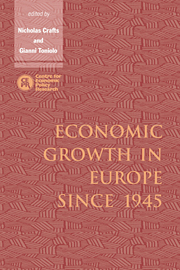Book contents
- Frontmatter
- Contents
- List of figures
- List of tables
- Preface
- List of contributors
- 1 Postwar growth: an overview
- 2 Institutions and economic growth: Europe after World War II
- 3 The varieties of Eurosclerosis: the rise and decline of nations since 1982
- 4 Why the 1950s and not the 1920s? Olsonian and non-Olsonian interpretations of two decades of German economic history
- 5 Convergence, competitiveness and the exchange rate
- 6 British economic growth since 1945: relative economic decline … and renaissance?
- 7 Economic growth in postwar Belgium
- 8 France, 1945–92
- 9 Economic growth and the Swedish model
- 10 Characteristics of economic growth in the Netherlands during the postwar period
- 11 Portuguese postwar growth: a global approach
- 12 Growth and macroeconomic performance in Spain, 1939–93
- 13 Irish economic growth, 1945–88
- 14 Italy
- 15 West German growth and institutions, 1945–90
- 16 An exercise in futility: East German economic growth and decline, 1945–89
- 17 Postwar growth of the Danish economy
- 18 Reflections on the country studies
- Index
10 - Characteristics of economic growth in the Netherlands during the postwar period
Published online by Cambridge University Press: 04 August 2010
- Frontmatter
- Contents
- List of figures
- List of tables
- Preface
- List of contributors
- 1 Postwar growth: an overview
- 2 Institutions and economic growth: Europe after World War II
- 3 The varieties of Eurosclerosis: the rise and decline of nations since 1982
- 4 Why the 1950s and not the 1920s? Olsonian and non-Olsonian interpretations of two decades of German economic history
- 5 Convergence, competitiveness and the exchange rate
- 6 British economic growth since 1945: relative economic decline … and renaissance?
- 7 Economic growth in postwar Belgium
- 8 France, 1945–92
- 9 Economic growth and the Swedish model
- 10 Characteristics of economic growth in the Netherlands during the postwar period
- 11 Portuguese postwar growth: a global approach
- 12 Growth and macroeconomic performance in Spain, 1939–93
- 13 Irish economic growth, 1945–88
- 14 Italy
- 15 West German growth and institutions, 1945–90
- 16 An exercise in futility: East German economic growth and decline, 1945–89
- 17 Postwar growth of the Danish economy
- 18 Reflections on the country studies
- Index
Summary
Introduction
The postwar development of the Dutch economy is characterized by major changes in structure and substantial variations in growth rates. Some of these changes it has in common with most other European countries, such as the rapid increase in per-capita output and productivity growth during the 1950s and 1960s. All European countries possessed a great potential for catch-up after the devastating effects of the Second World War. However, other aspects of Dutch postwar economic growth are unique, such as the low labour force participation rates in terms of total hours worked, a high ratio of foreign trade to GDP, and an extensive and costly welfare system.
In geographic and demographic terms the Netherlands is also exceptional. It is one of the smallest but most densely populated countries on the European continent. There are on average 446 people per square kilometre, and the density is even twice this in the ‘Randstad’ (the area around Amsterdam, the Hague, Rotterdam and Utrecht), where almost 7 million of the 15.4 million inhabitants live, mostly below sea level.
The central proposition of this chapter is that during the postwar period the Dutch economy has gradually fallen behind the rest of what we will call north-western Europe in terms of per-capita income, whereas its productivity level has remained relatively high. In section we present some main characteristics of the long-run growth performance of the Dutch economy. This is followed by a chronological account of postwar growth.
- Type
- Chapter
- Information
- Economic Growth in Europe since 1945 , pp. 290 - 328Publisher: Cambridge University PressPrint publication year: 1996
- 1
- Cited by



